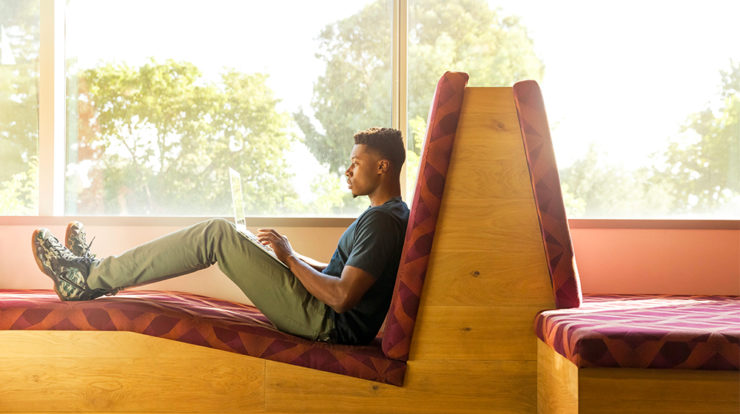

Features
The Impact and Benefits of Biophilia in the Workplace
Bill Browning
Share
Learn more about our biophilic design work and services by emailing us at [email protected] and reading our reports, 14 Patterns of Biophilic Design and The Economics of Biophilia. Follow the conversation on twitter: @TerrapinBG | #14Patterns.
This interview is a re-post from the Coalesse blog. Find the original post and explore the blog here.
It’s obvious that workers feel better when they have access to natural elements, like sunlight, fresh air and plants. But Bill Browning, environmental strategist and founding partner of Terrapin Bright Green, has the scientific data to prove that nature is good for us.
One of the green building and real estate industry’s foremost thinkers and strategists, Bill is an advocate for sustainable design solutions in all sectors and industries. He recently spoke at an event hosted by Coalesse, Sagegreenlife and Forward Space on the science related to experiencing living things. Below, we asked him to share some of his insights on bringing the natural world into built spaces.
What is biophilia?
Biophilia literally means love of life; Harvard biologist E.O. Wilson describes biophilia as the innate human need to affiliate with life.

Bill discusses the value of biophilic design at a recent Coalesse event. Photo courtesy of Coalesee.
Why is biophilia important to a built environment like an office building?
As a species we evolved on the savannas of Africa, today we are spread across the planet and more than half the population lives in urban areas. Here in the US, we spend more than 90% of our lives inside buildings. So biophilic design is focused on bringing experiences of nature to us in the built environment; this can include living plants, water, daylight, natural materials, fractal patterns, and spaces that support prospect views or provide a refuge condition.
How does biophilia impact how we experience a space?
There is also a growing body of research that shows the spaces we inhabit have distinct physiological and psychological impacts on us. Spaces with elements of biophilic design are more attractive and have been found to increase use of the space.
What are the benefits of biophilia to the individual workers and the organization?
Biophilic experiences can reduce stress, improve cognitive function, and enhance mood and creativity. These and other outcomes can increase health and wellbeing, as well as productivity.
What is the future of biophilic design? What are some trends within biophilic design that you’ve noticed?
One of the trends we have observed is using biophilic design to support changing functions of spaces, such as hotel lobbies as workspaces, work spaces using elements of residential design, and other spaces like airports and transit hubs adopting guest experience strategies seen in hospitality design. I think that increasing biophilic design will be used to convey messages about brand, and a signal about caring for building occupants.
Why is biophilic design such a significant conversation in the design industry right now?

An effective use of biophilia focuses on just one or two elements well implemented, advises Bill Browning. Photo courtesy of Coalesse.
Many companies are increasingly focused on improving the health and wellbeing of their employees, frequently through programmatic efforts like yoga, meditation, and healthier food offerings. Biophilic design is a strategy to support health and wellbeing of everyone in the office through the design of spaces themselves. Different biophilic design elements support different outcomes, some help with stress reduction, others with cognitive function. Choosing the desired outcomes can then help determine which design elements will be the most effective.
What are some of the main challenges & opportunities in incorporating biophilic elements in the workplace?
Similar to the early green building movement, there are concerns about the changes in first costs and the costs for ongoing maintenance of various features of biophilic design. There are opportunities for every workplace to incorporate biophilic design, whether it’s a small intervention like the art selection in an existing building or creating a space from the ground up that incorporates biophilic design throughout. With time, the challenges will begin to fade as more projects illustrate the scale of opportunities for biophilic elements and their value.
How should architects and designers approach biophilia when creating a space? What are some strategies they should use?
One of the key lessons is that while there are many different elements that can be used in a biophilic design, a really effective intervention focuses on just one or two elements really well implemented. Placement is also important; a green wall in a foyer is nice, but a green wall that can be seen by the majority of the occupants from their workstation is much more effective.
Topics
- Environmental Values
- Speaking
- LEED
- Terrapin Team
- Phoebe
- Community Development
- Greenbuild
- Technology
- Biophilic Design Interactive
- Catie Ryan
- Spanish
- Hebrew
- French
- Portuguese
- Publications
- Occupant Comfort
- Materials Science
- Conference
- Psychoacoustics
- Education
- Workshop
- Mass Timber
- Transit
- Carbon Strategy
- connection with natural materials
- interior design
- inspirational hero
- biophilia
- economics of biophilia
- Sustainability
- wood
- case studies
- Systems Integration
- Biophilic Design
- Commercial
- Net Zero
- Resorts & Hospitality
- Energy Utilization
- Water Management
- Corporations and Institutions
- Institutional
- Ecosystem Science
- Green Guidelines
- Profitability
- Climate Resiliency
- Health & Wellbeing
- Indoor Environmental Quality
- Building Performance
- Bioinspired Innovation
- Biodiversity
- Residential
- Master Planning
- Architects and Designers
- Developers and Building Owners
- Governments and NGOs
- Urban Design
- Product Development
- Original Research
- Manufacturing
- Industrial Ecology
- Resource Management
- Sustainability Plans
- Health Care
- Carbon Neutrality


